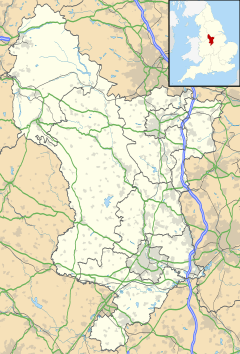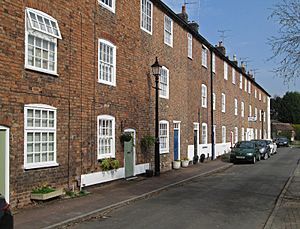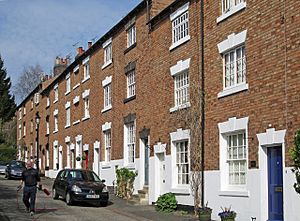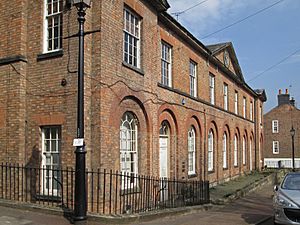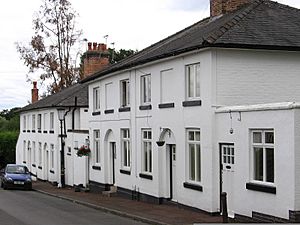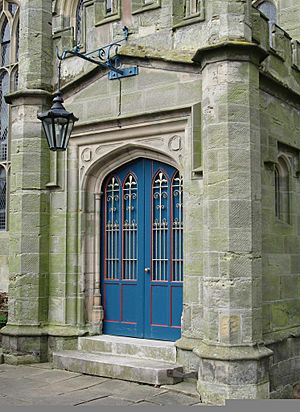Darley Abbey facts for kids
Quick facts for kids Darley Abbey |
|
|---|---|
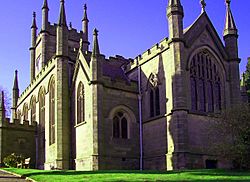 St Matthew's Church |
|
| Unitary authority | |
| Ceremonial county | |
| Region | |
| Country | England |
| Sovereign state | United Kingdom |
| Post town | Derby |
| Postcode district | DE22 |
| Police | Derbyshire |
| Fire | Derbyshire |
| Ambulance | East Midlands |
| EU Parliament | East Midlands |
Darley Abbey is a historic village that is now part of the city of Derby in England. It's about 1.4 miles (2.2 km) north of Derby city centre, next to the River Derwent.
The area has a long history, starting with a monastery in the Middle Ages. Later, in the 1700s, the Evans family built a famous mill village here. Today, Darley Abbey is part of the Derwent Valley Mills World Heritage Site. This means it's a very important historical place. It became part of Derby city in 1968.
Contents
History of Darley Abbey
The Old Monastery
Darley Abbey was once home to an Augustinian monastery. It was founded around 1154-1160. A local church, St Helen's Priory, helped start it. Many monks from St Helen's Priory moved to Darley Abbey.
The monastery received many gifts of land and money. These gifts came mostly from people in Derby. The monastery became quite wealthy. For example, in 1291, its income was over £72.
However, by the early 1300s, the monastery faced hard times. Some say bad harvests and sick animals caused problems. Others blamed the Abbot, who was accused of wasting the monastery's money.
In 1535, the monastery's income was recorded as £258. But soon after, in 1538, the monastery was closed down. This was part of the Dissolution of the Monasteries across England.
Today, only two buildings from the monastery remain. One is now called the Abbey Pub. It was built in the 1400s and might have been part of the Abbot's home. The other part is now a private house on Abbey Lane.
The Famous Mills
The industrial history of Darley Abbey began long ago. Even before the famous cotton mills, there were water-powered mills here. These mills processed things like corn, flint, leather, and paper.
In 1778, the Evans family bought land by the River Derwent. They built cotton mills there between 1782 and 1830. These mills became known as the 'Boar's Head Mills'. The Boar's Head was the Evans family symbol.
The mills made high-quality thread for sewing and embroidery. The site has five main mill buildings and many other structures. These include warehouses, offices, and stables. The tallest building is six storeys high.
The oldest building, Long Mill, had a special attic floor. Until 1819, this attic was used as a schoolroom. Children who worked at the mill received a basic education there.
The mills were first powered by water from the River Derwent. Weirs (small dams) on the river created the water power. Later, steam power was also used to help run the machinery.
The Evans family stopped owning the mills in 1903. The Peacock family then ran the business until 1943. After that, it was sold to a larger company. Textile production stopped in 1970.
Today, Darley Abbey Mills is a busy place. It has many different businesses, including engineering and offices. Since 2010, more shops, restaurants, and entertainment venues have opened there.
The Mill Village
Thomas Evans, the mill owner, built a new village for his workers. Between 1792 and 1826, he built over 130 houses. The village was on the west side of the river. A toll bridge connected it to the mills.
The village was built in stages:
- 1792 - Houses on Darley Street were built.
- 1792 - Flat Square and West Row were constructed. These were three-storey buildings forming an open square.
- 1792 - "The Four Houses" off Mile Ash Lane were built. These four three-storey houses were for mill foremen. They are the oldest example of "cluster" housing in England.
- 1797 - Brick Row was built. This was a terrace of three-storey brick houses. The attic space in the middle of this row was planned as a school. It replaced the schoolroom in Long Mill.
- 1800 - Lavender Row was added. This is a Georgian terrace with houses "stepped" up the sloped land.
- 1819 - St Matthew's School was designed by Moses Wood. It had large, bright classrooms. It also included homes for the schoolmaster and schoolmistress.
- 1826 - White-painted terraces on New Road were built. These brick houses were painted white. Senior mill employees lived in these homes.
A visitor in 1829 praised the village. They noted the neat and comfortable houses. They saw flowers growing in front of the homes. The visitor felt that the Evans family had created a wonderful place for their workers.
St Matthew's Church
After the monasteries closed, Darley Abbey had no church. Villagers had to travel to Derby for church services until 1819.
Then, Walter Evans, one of the mill owners, paid for a new church. It was called St Matthew's Church. The architect, Henry Moses Wood, also designed St Matthew's School. The church was built in the Gothic style. Stone for its construction came from local quarries. The church was made much larger in 1895–96.
Protecting History
Darley Abbey is very important historically. Because of this, much of the village is a special "conservation area." This means there are strict rules about new buildings and changes. The conservation area includes the mills, the workers' houses, the park, and the church.
Darley Abbey is also part of the Derwent Valley Mills World Heritage Site. This site stretches from Matlock Bath to Derby. Being a World Heritage Site means it's recognized globally for its unique history.
Local Features
Darley Park
Darley Park is a beautiful park covering about 80 acres (32 hectares). It has many different gardens and wildlife areas. The Evans family, who lived at Darley Hall, gave the park to the people of Derby in 1931. Darley Hall was taken down in the 1960s. However, parts of its ground floor remain and are now used as a terrace for a small cafe. Darley Park used to host a very popular free open-air concert.
Local Schools
- Saint Benedict Catholic Voluntary Academy is one of the largest schools in Derby. It has about 1500 students. The school started in 1986, but other schools were on this site before.
- Saint Mary's Catholic School is an old Catholic school for boys and girls. Its history goes back to 1813 or 1814. The school has moved to new buildings three times since then.


